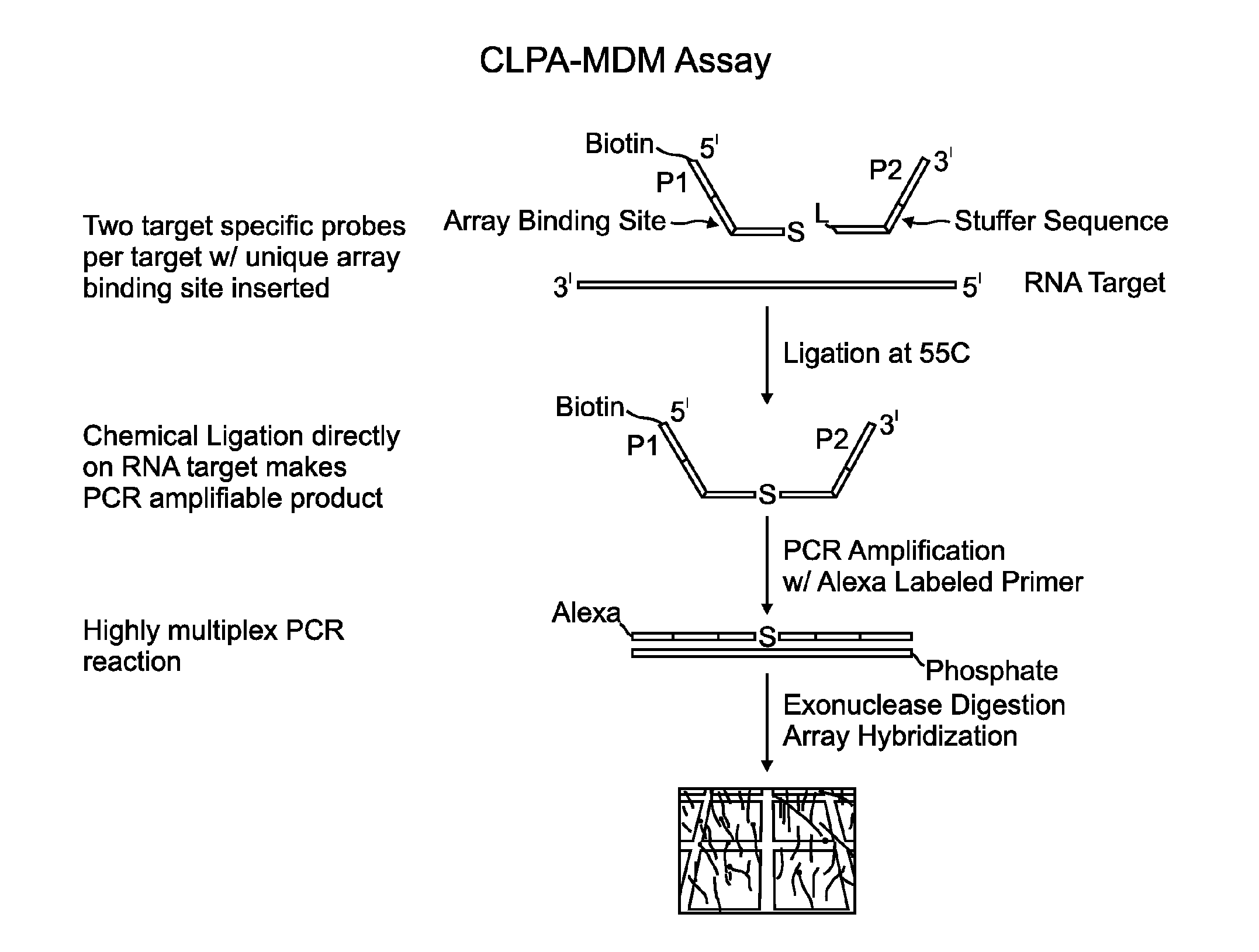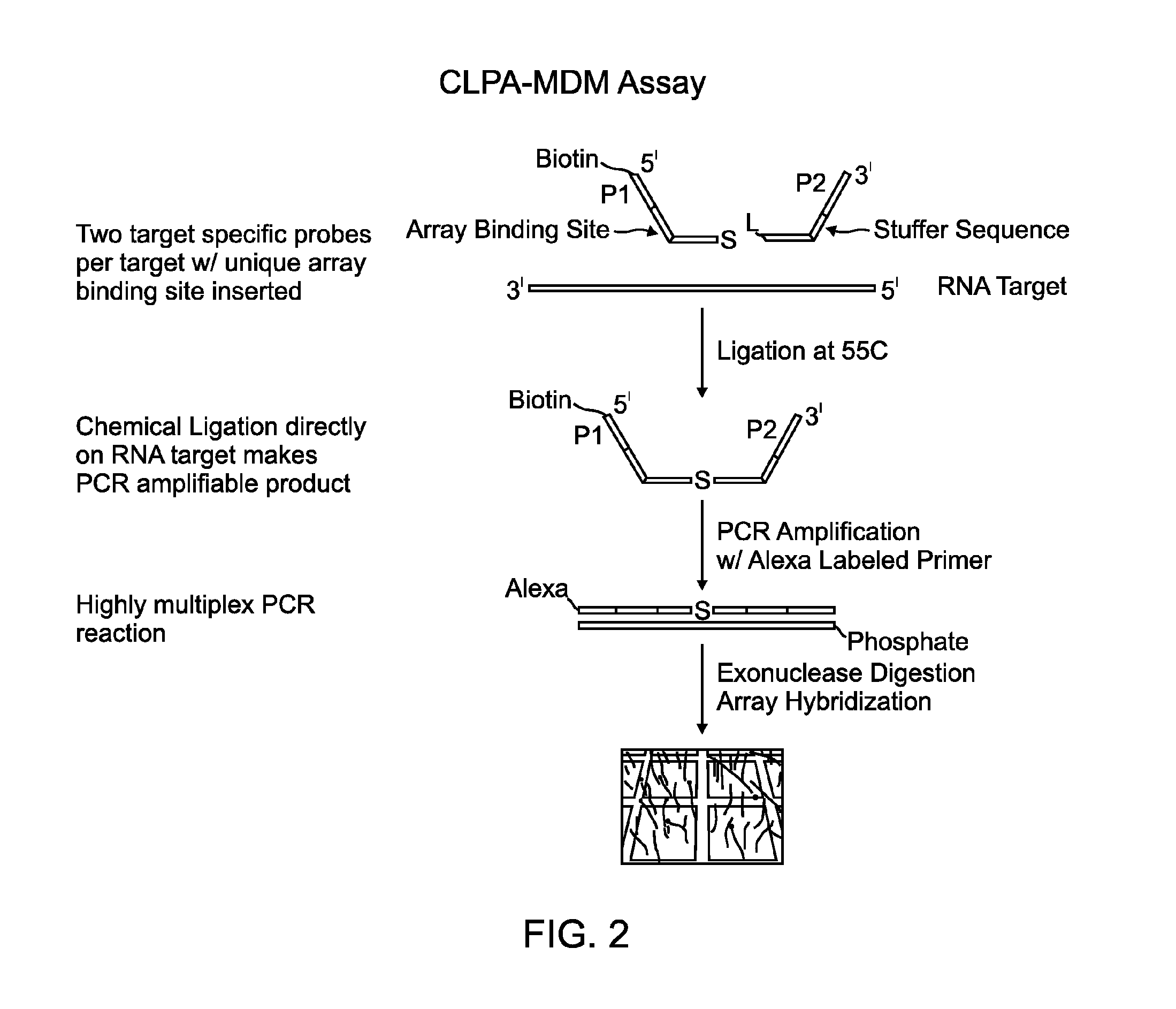Methods and compositions for detecting target nucleic acids
a nucleic acid and target technology, applied in the field of gene probe assays, can solve the problems of inability to uniformly distribute the degradation of rna occurring during the isolation procedure, the instability of the rna itself, etc., and achieve the effect of greatly simplifying the process of detecting and measuring target nucleic acids and rapid target detection
- Summary
- Abstract
- Description
- Claims
- Application Information
AI Technical Summary
Benefits of technology
Problems solved by technology
Method used
Image
Examples
example 1
Quantitative Multiplex Detection of Five Targets
[0330]Multiplex CLPA reactions were performed using five (5) DNA target mimics (corresponding to portions of the MOAP1(SEQ ID NO:5), PCNA(SEQ ID NO:9), DDB2(SEQ ID NO:12), BBC3(SEQ ID NO:16) and BAX(SEQ ID NO:19) genes) combined in one reaction in the presence of their respective CLPA probes (Table 1) (S and L probes at 1 nM each). The target mimics were pooled in different concentration as shown in Table 2. The target mimics, S probes and L probes were incubated in PCR buffer (1×PCR buffer is 1.5 mM MgCL2, 50 mM KCl, 10 mM Tris-HCl pH 8.3) for 1 hour at 50° C. A 1 μl aliquot of each reaction mixture was used as template for PCR amplification using Dynamo SYBR green PCR mix in the presence of Universal Primers (SEQ ID NOS 1 and 2, 300 nM). The samples were PCR cycled for 27 cycles (95° C. 15 min followed by 27 cycles of 95° C. (10s), 60° C. (24s), 72° C. (10s). After PCR amplification, the samples were denatured and injected into an AB...
example 2
CLPA Reactions Using MOAP1 and DDB2 DNA and RNA Target Mimics
[0331]Reactions were prepared in duplicate as presented in Table 3 using DNA or RNA target mimics for the MOAP1 and DDB2 genes and CLPA probes sets designed to target the sequences. The probe numbers refer to the SEQ ID NOs in Table 1. The reagents were added in the concentrations and volumes shown in Table 4. The respective S-probe, L-probe and target mimic were heated to 50° C. for 60 minutes in a 0.2 mL PCR tube, after which 2.5 μl of the CLPA reaction was used as template in a real-time PCR reaction with 40 amplification cycles. Real-time PCR data was averaged for the duplicate samples and is presented in Table 3 (Ct value column). Minimal differences in Ct value between RNA and DNA target mimics were observed indicating similar probe ligation efficiency on RNA and DNA substrates.
TABLE 3CLPA Probe Sets.L-ProbeS-ProbeTarget Mimic(1 nM)(1 nM)(10 pM)CtSampleIdentifierSEQ ID NOSEQ ID NOSEQ ID NOvalue1MOAP-134519.5DNA2MOAP-...
example 3
Direct Analysis of DDB2 RNA Transcripts in Lysis Buffer and Lysed Blood
[0332]DDB2 messenger RNA (mRNA) was prepared using an in-vitro transcription kit from Ambion and a cDNA vector plasmid from Origene (SC122547). The concentration of mRNA was determined using PicoGreen RNA assay kit from Invitrogen. The DDB2 probe sets (Table 5) were tested with different concentrations of DDB2 mRNA transcript spiked into either water or whole blood. The reactions mixture components are listed in Table 5. Samples 1-4 consisted of DDB2 transcript at 10 ng, 1 ng, 0.1 ng and 0.01 ng in water, and samples 5-8 consisted of the same concentration range spiked into whole blood. Similar reactions protocols were followed with the exception of adding Proteinase K to the blood samples so as to reduce protein coagulation. The procedure is as follows: The reagents were added in the concentrations and volumes in Table 5 and Table 6.
[0333]The RNA transcripts were stable once combined with the buffer prior to the...
PUM
| Property | Measurement | Unit |
|---|---|---|
| Time | aaaaa | aaaaa |
| Molar density | aaaaa | aaaaa |
| Molar density | aaaaa | aaaaa |
Abstract
Description
Claims
Application Information
 Login to View More
Login to View More - R&D
- Intellectual Property
- Life Sciences
- Materials
- Tech Scout
- Unparalleled Data Quality
- Higher Quality Content
- 60% Fewer Hallucinations
Browse by: Latest US Patents, China's latest patents, Technical Efficacy Thesaurus, Application Domain, Technology Topic, Popular Technical Reports.
© 2025 PatSnap. All rights reserved.Legal|Privacy policy|Modern Slavery Act Transparency Statement|Sitemap|About US| Contact US: help@patsnap.com



